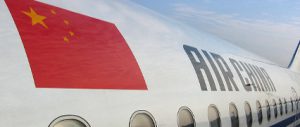The European Union is embroiled in a legal battle it can’t afford to lose without weakening a key pillar of its energy policy and undermining its leadership position in global climate-change negotiations.
If all goes to plan, from January 1 next year the carbon emissions of flights operated by all airlines which take off or land within the EU will be included in the region’s Emissions Trading Scheme (ETS). But airline companies and non-EU governments are doing their best to block the changes, which they argue violate international law.
Yesterday, 26 countries outside the European Union were due to file a formal rebuff of the plans with the International Civil Aviation Organization. Meanwhile, a judgment is expected early in the new year from the European Court of Justice in a case brought against the EU by north American carriers. And China has stepped up the rhetoric about its own plans to initiate “legal action”, which it says will happen before the end of the year, though what form that will take is unclear. It has also stopped the sale of 10 European-manufactured Airbus A380s to Hong Kong airlines. (See chinadialogue’s roundtable of expert views from China for more)
With so much at stake, it is worth taking a closer look at what the EU is trying to do and why it has caused so much controversy. The obvious question to ask is: why is the EU waging this battle?
Incentives
Air travel currently contributes only 2% to 3% of man-made greenhouse-gas emissions globally, but this proportion is expected to rise as demand increases and other sectors, such as the energy industry, take action to reduce their carbon footprints. The aviation industry has long focused on reducing fuel burn, originally with a view to increasing operating range, more recently as a cost-reduction strategy and, finally, in an effort to reduce greenhouse-gas emissions.
The improvements have mainly been technological, but the current system is considered mature, which limits opportunities for further incremental improvements. More dramatic changes, such as open-rotor systems and blended wing bodies – a flying wing design – are both challenging and expensive to develop, issues compounded by the risk-adverse nature of the aviation industry.
Another factor is the limited impact that new systems have on the existing fleet, because the operational lifetimes of aircraft are so long. Premier airlines may replace aircraft relatively frequently, but low-value operators often use planes that are 15 to 20 years old. This results in the civil aviation fleet having a technology level some 15 years behind the current standard. It is in light of these challenges that the European Union has seen fit to include aviation in the ETS, to help to provide an incentive for the industry to address climate change in its business practices.
The EU ETS is a “cap-and-trade” system. It forms a major part of the European Union’s climate policy in its efforts to reduce greenhouse-gas emissions by at least 80% below 1990 levels by 2050. Currently, it covers firms in the energy and industrial sectors which have a net heat use of 20 megawatts or more. These firms comprise some 10,000 individual units, accounting for 40% of the total greenhouse-gas emissions from the European Union.
Cap-and-trade systems are a market-based approach to limiting pollution. They operate by a central authority, usually a governmental body but in this case the European Union, limiting the amount of emissions a given sector can produce. The total amount is then allocated or auctioned to individual emitters in the form of permits, which must be surrendered on use. Excess permits can be traded to firms that are unwilling or unable to reduce emissions.
In theory, this scheme allows for the most cost-efficient method of reducing emissions, as those firms that can lower emissions cheaply will do so, releasing permits onto the market. Cap-and-trade is particularly suited to pollutants that have little or no effect at the point of emissions but are felt uniformly, such as greenhouse-gas emissions.
The success of such programmes hinges on the establishment of a relatively stable permit price, giving firms an incentive to invest in emission reduction. The scheme for aviation requires all operators, both EU and non-EU, to allocate permits – and therefore charges – to the whole of any journey that starts or ends in the European Union. In order to reduce emissions, the cap is set at 97% of greenhouse-gas emissions from a 2004 to 2006 baseline, and is due to be reduced to 95% by 2014.
Fierce reaction
So why has this plan provoked such a fierce reaction? Opposition to the scheme comes from both those with a stake in the aviation sector and non-EU governments. Opponents focus on the effect on EU competitiveness and on the legality of imposing the scheme on non-EU airline operators. The airlines argue that, by imposing extra costs on them, the ETS has the potential to decrease profitability of the sector, damaging competitiveness. It is expected that a significant percentage of the cost increases will be passed to the consumer, reducing demand and possibly impacting service levels, with some of the less profitable routes being withdrawn.
Studies suggest low-cost airlines could be hit hardest, as the increased cost will be a greater proportion of their ticket price. Also, as the scheme has no set EU-wide allocation method, it could cause distortion between EU-based airlines, as different countries may allocate more free permits than others.
Competition between EU and non-EU airlines is also a point of concern, as non-EU airlines can avoid operating within the geographical area where the scheme is applied. However the impact of this is expected to be minimal as the expected cost increase is low, landing rights are country-specific and time-consuming to arrange and the current code-sharing “hub-and-spoke” business model (where traffic moves along “spokes” connected to a central hub) would be challenging to operate by abandoning EU airspace. There are also concerns regarding how the charges collected will be spent, as there is no requirement for the funds to be kept in the aviation sector.
The key political argument against EU-ETS, which is yet to be settled, is the legality of the action. Opponents have claimed that the inclusion of aviation in the ETS contravenes customary international law and various international agreements. They argue that the allocation of permits for journeys outside the EU’s jurisdiction (including over the high seas) contravenes: the customary international laws of the sovereignty of states over their own airspace; the right to fly over and the invalidity of claims of sovereignty over the high seas; the Chicago Convention, an international agreement which establishes the rules of airspace and international aviation; the Kyoto Protocol, an international treaty on climate-change mitigation; and the Open Skies Agreement, which is an international policy on liberalised aviation markets.
Opponents of the scheme claim that EU-ETS breaches three articles of the Chicago Convention: article 1, pertaining to the sovereignty of every state to its own airspace, in that it require permits for airspace outside of the EU; and articles 15 and 24, which limit the ability of a country to tax or charge airlines of another country of the Chicago Convention. Under the Kyoto Protocol, developing nations including China are exempt from legally binding obligations to reduce emissions, which would include airlines operating from such countries. And EU-ETS breaches articles 7 (application of laws) and 15 (mitigation of impact of environmental protection measures) of the Open Skies Agreement.
Beyond the judgment
The European Union’s hopes of success were given a boost in October, when a legal opinion by the Advocate General of the European Court of Justice stated that the inclusion of international aviation into the EU-ETS is compatible with international law. This announcement is not binding and the judges will give their judgment at a later date, though the judgment often follows the opinion.
But what does this mean? If the judgment finds in favour of the EU, the inclusion of aviation of EU-ETS will occur on January 1, 2012, and will likely lead to retaliatory actions by non-EU governments. This could range from condemnation to sanctions, both political and economic, such as cancelling orders of aircraft from French-owned Airbus or applying charges or taxes on EU airlines, such as Russia’s threat to double over-flight charges.
Were the EU to lose the case there would be two main implications. Firstly, a key pillar of EU energy policy would be weakened as EU-ETS would be found to contravene international law, making it less applicable as a greenhouse-gas mitigation scheme. Secondly, the EU’s attempt at leadership in international climate change negotiations would be undermined by the failure of its flagship programme. Either way, the row looks set to continue for some time to come.
Christian Carey is aviation expert at Oxford University’s Smith School of Enterprise and the Environment.
Homepage image by Foto Jenny
For more on the aviation row, and the opinions of a roundtable of Chinese experts, read "The view from Chinese airspace".





